HUMMER H3 2008 Owners Manual
Manufacturer: HUMMER, Model Year: 2008, Model line: H3, Model: HUMMER H3 2008Pages: 416, PDF Size: 5.66 MB
Page 131 of 416
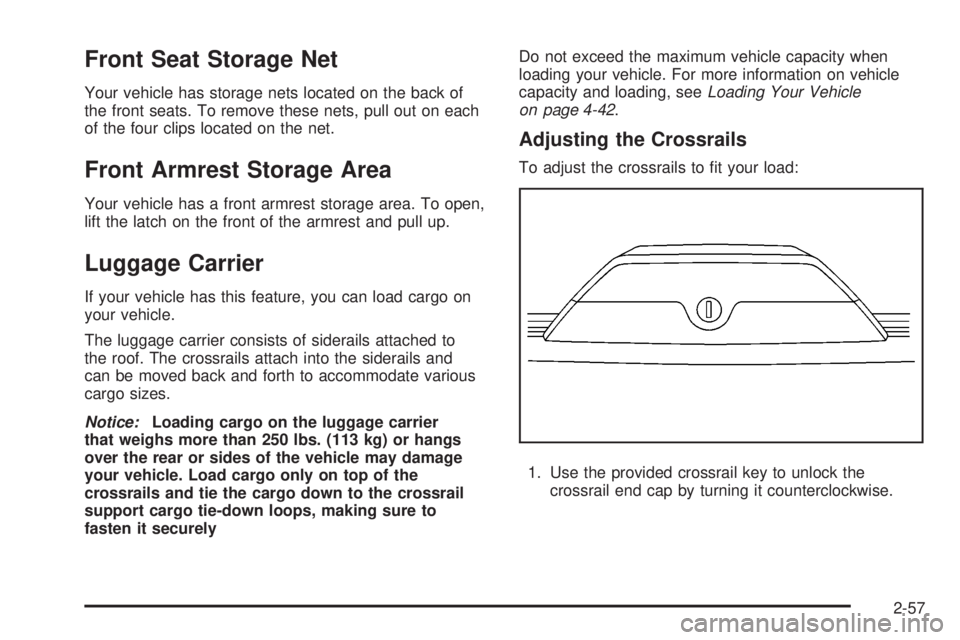
Front Seat Storage Net
Your vehicle has storage nets located on the back of
the front seats. To remove these nets, pull out on each
of the four clips located on the net.
Front Armrest Storage Area
Your vehicle has a front armrest storage area. To open,
lift the latch on the front of the armrest and pull up.
Luggage Carrier
If your vehicle has this feature, you can load cargo on
your vehicle.
The luggage carrier consists of siderails attached to
the roof. The crossrails attach into the siderails and
can be moved back and forth to accommodate various
cargo sizes.
Notice:Loading cargo on the luggage carrier
that weighs more than 250 lbs. (113 kg) or hangs
over the rear or sides of the vehicle may damage
your vehicle. Load cargo only on top of the
crossrails and tie the cargo down to the crossrail
support cargo tie-down loops, making sure to
fasten it securelyDo not exceed the maximum vehicle capacity when
loading your vehicle. For more information on vehicle
capacity and loading, seeLoading Your Vehicle
on page 4-42.
Adjusting the Crossrails
To adjust the crossrails to �t your load:
1. Use the provided crossrail key to unlock the
crossrail end cap by turning it counterclockwise.
2-57
Page 132 of 416
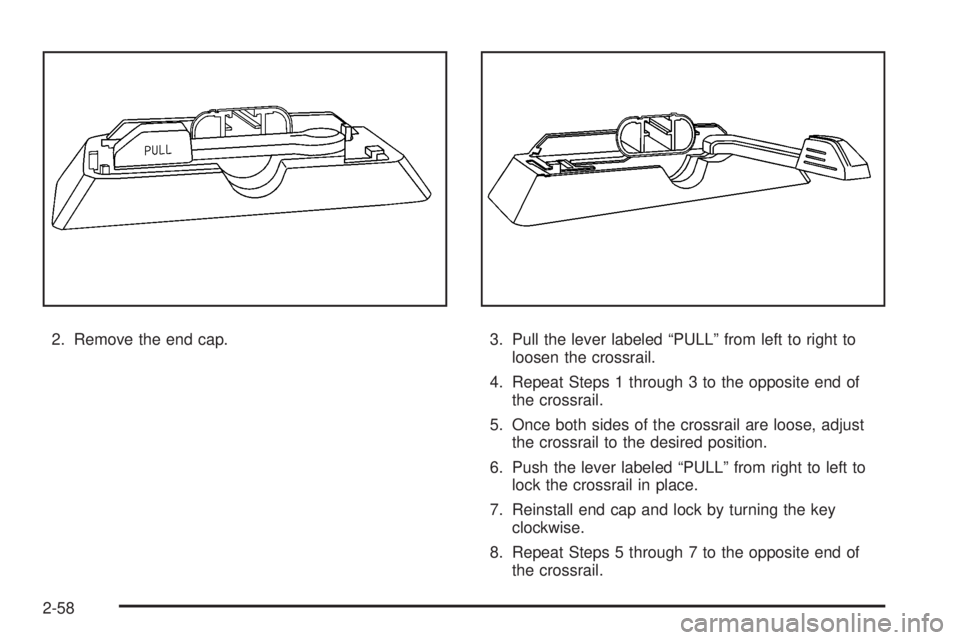
2. Remove the end cap. 3. Pull the lever labeled “PULL” from left to right to
loosen the crossrail.
4. Repeat Steps 1 through 3 to the opposite end of
the crossrail.
5. Once both sides of the crossrail are loose, adjust
the crossrail to the desired position.
6. Push the lever labeled “PULL” from right to left to
lock the crossrail in place.
7. Reinstall end cap and lock by turning the key
clockwise.
8. Repeat Steps 5 through 7 to the opposite end of
the crossrail.
2-58
Page 133 of 416
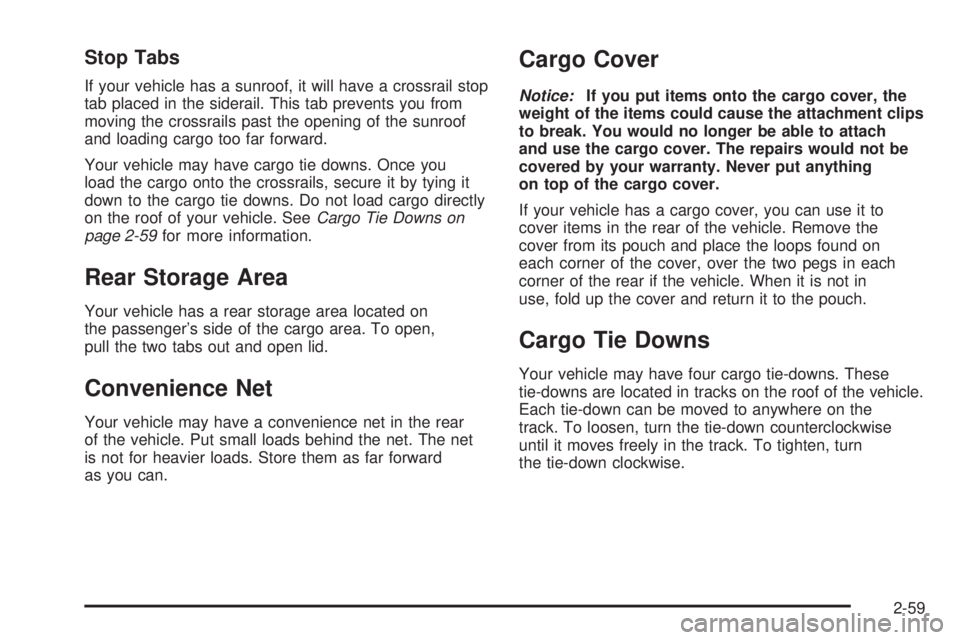
Stop Tabs
If your vehicle has a sunroof, it will have a crossrail stop
tab placed in the siderail. This tab prevents you from
moving the crossrails past the opening of the sunroof
and loading cargo too far forward.
Your vehicle may have cargo tie downs. Once you
load the cargo onto the crossrails, secure it by tying it
down to the cargo tie downs. Do not load cargo directly
on the roof of your vehicle. SeeCargo Tie Downs on
page 2-59for more information.
Rear Storage Area
Your vehicle has a rear storage area located on
the passenger’s side of the cargo area. To open,
pull the two tabs out and open lid.
Convenience Net
Your vehicle may have a convenience net in the rear
of the vehicle. Put small loads behind the net. The net
is not for heavier loads. Store them as far forward
as you can.
Cargo Cover
Notice:If you put items onto the cargo cover, the
weight of the items could cause the attachment clips
to break. You would no longer be able to attach
and use the cargo cover. The repairs would not be
covered by your warranty. Never put anything
on top of the cargo cover.
If your vehicle has a cargo cover, you can use it to
cover items in the rear of the vehicle. Remove the
cover from its pouch and place the loops found on
each corner of the cover, over the two pegs in each
corner of the rear if the vehicle. When it is not in
use, fold up the cover and return it to the pouch.
Cargo Tie Downs
Your vehicle may have four cargo tie-downs. These
tie-downs are located in tracks on the roof of the vehicle.
Each tie-down can be moved to anywhere on the
track. To loosen, turn the tie-down counterclockwise
until it moves freely in the track. To tighten, turn
the tie-down clockwise.
2-59
Page 134 of 416
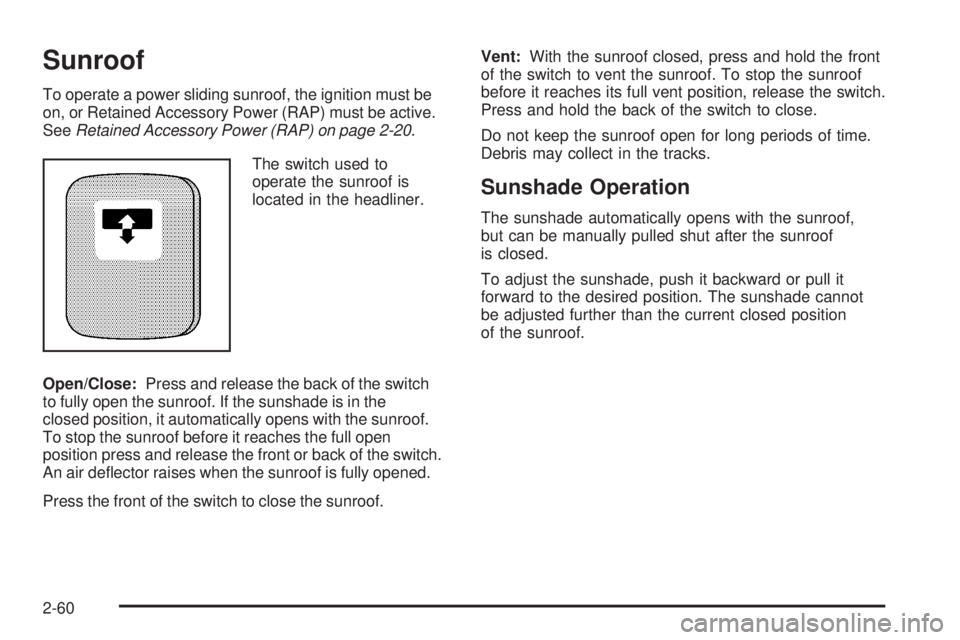
Sunroof
To operate a power sliding sunroof, the ignition must be
on, or Retained Accessory Power (RAP) must be active.
SeeRetained Accessory Power (RAP) on page 2-20.
The switch used to
operate the sunroof is
located in the headliner.
Open/Close:Press and release the back of the switch
to fully open the sunroof. If the sunshade is in the
closed position, it automatically opens with the sunroof.
To stop the sunroof before it reaches the full open
position press and release the front or back of the switch.
An air de�ector raises when the sunroof is fully opened.
Press the front of the switch to close the sunroof.Vent:With the sunroof closed, press and hold the front
of the switch to vent the sunroof. To stop the sunroof
before it reaches its full vent position, release the switch.
Press and hold the back of the switch to close.
Do not keep the sunroof open for long periods of time.
Debris may collect in the tracks.
Sunshade Operation
The sunshade automatically opens with the sunroof,
but can be manually pulled shut after the sunroof
is closed.
To adjust the sunshade, push it backward or pull it
forward to the desired position. The sunshade cannot
be adjusted further than the current closed position
of the sunroof.
2-60
Page 135 of 416

Instrument Panel Overview...............................3-4
Hazard Warning Flashers................................3-6
Other Warning Devices...................................3-6
Horn.............................................................3-6
Tilt Wheel.....................................................3-7
Turn Signal/Multifunction Lever.........................3-7
Turn and Lane-Change Signals........................3-8
Headlamp High/Low-Beam Changer..................3-9
Flash-to-Pass.................................................3-9
Windshield Wipers........................................3-10
Windshield Washer.......................................3-10
Rear Window Wiper/Washer...........................3-11
Cruise Control..............................................3-11
Exterior Lamps.............................................3-15
Headlamps on Reminder................................3-16
Daytime Running Lamps (DRL).......................3-17
Automatic Headlamp System..........................3-17
Off-Road Lamps...........................................3-18
Fog Lamps..................................................3-19
Instrument Panel Brightness...........................3-19
Dome Lamp.................................................3-19
Dome Lamp Override....................................3-20
Exit Lighting.................................................3-20
Reading Lamps............................................3-20Electric Power Management...........................3-20
Battery Run-Down Protection..........................3-20
Accessory Power Outlet(s).............................3-21
Ashtray(s) and Cigarette Lighter......................3-22
Climate Controls............................................3-22
Climate Control System.................................3-22
Outlet Adjustment.........................................3-24
Warning Lights, Gages, and Indicators............3-25
Instrument Panel Cluster................................3-26
Speedometer and Odometer..........................
.3-27
Trip Odometer..............................................3-27
Tachometer.................................................3-27
Safety Belt Reminders...................................3-28
Airbag Readiness Light..................................3-29
Passenger Airbag Status Indicator...................3-30
Charging System Light..................................3-32
Up-Shift Light...............................................3-32
Brake System Warning Light..........................3-33
Antilock Brake System Warning Light...............3-34
Traction Off Light..........................................3-34
StabiliTrak
®Not Ready Light..........................3-34
Engine Coolant Temperature Gage..................3-35
Tire Pressure Light.......................................3-35
Section 3 Instrument Panel
3-1
Page 136 of 416
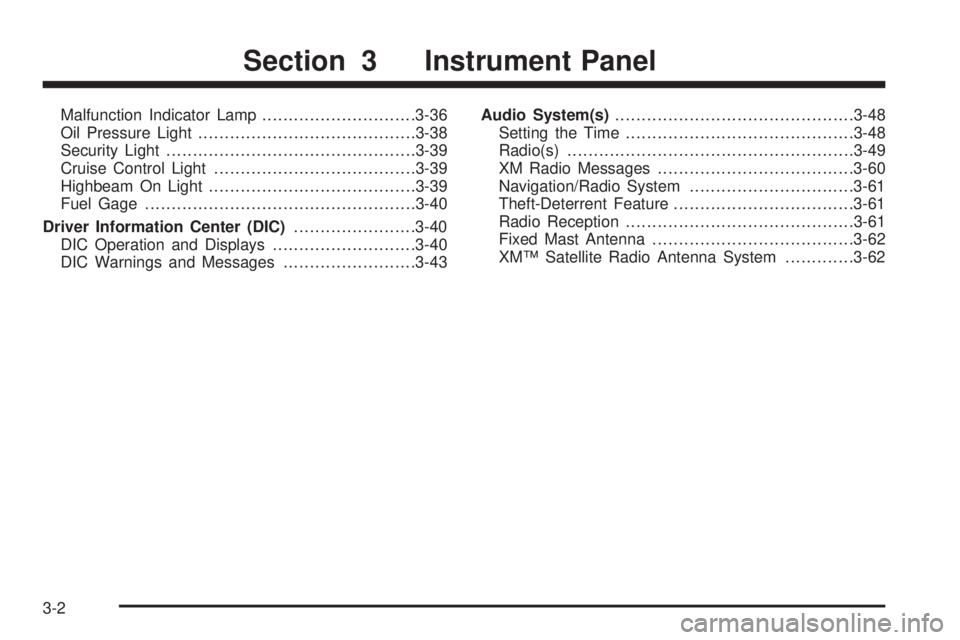
Malfunction Indicator Lamp.............................3-36
Oil Pressure Light.........................................3-38
Security Light...............................................3-39
Cruise Control Light......................................3-39
Highbeam On Light.......................................3-39
Fuel Gage...................................................3-40
Driver Information Center (DIC).......................3-40
DIC Operation and Displays...........................3-40
DIC Warnings and Messages.........................3-43Audio System(s).............................................3-48
Setting the Time...........................................3-48
Radio(s)......................................................3-49
XM Radio Messages.....................................3-60
Navigation/Radio System...............................3-61
Theft-Deterrent Feature..................................3-61
Radio Reception...........................................3-61
Fixed Mast Antenna......................................3-62
XM™ Satellite Radio Antenna System.............3-62
Section 3 Instrument Panel
3-2
Page 137 of 416
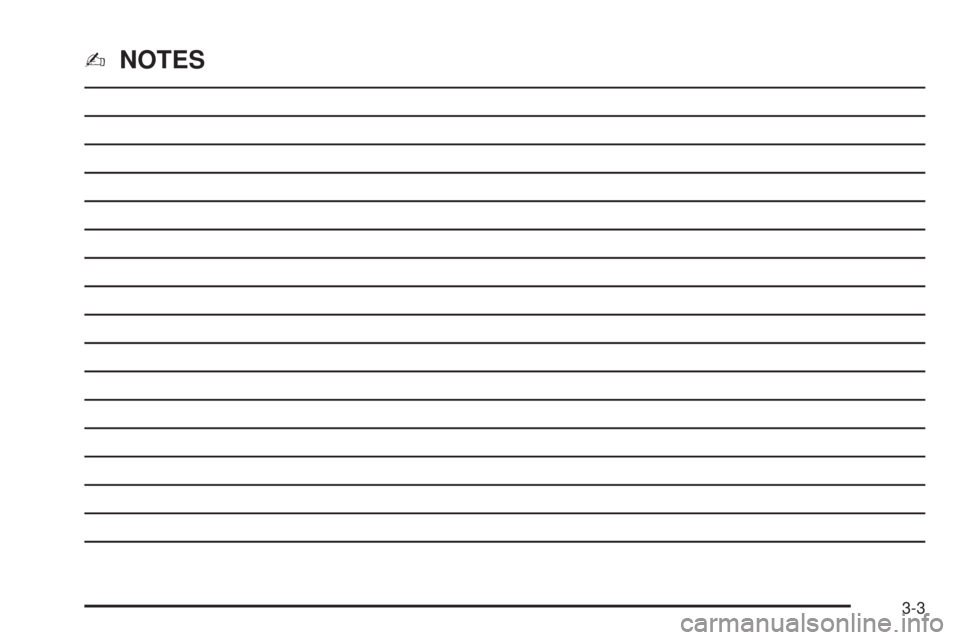
✍NOTES
3-3
Page 138 of 416
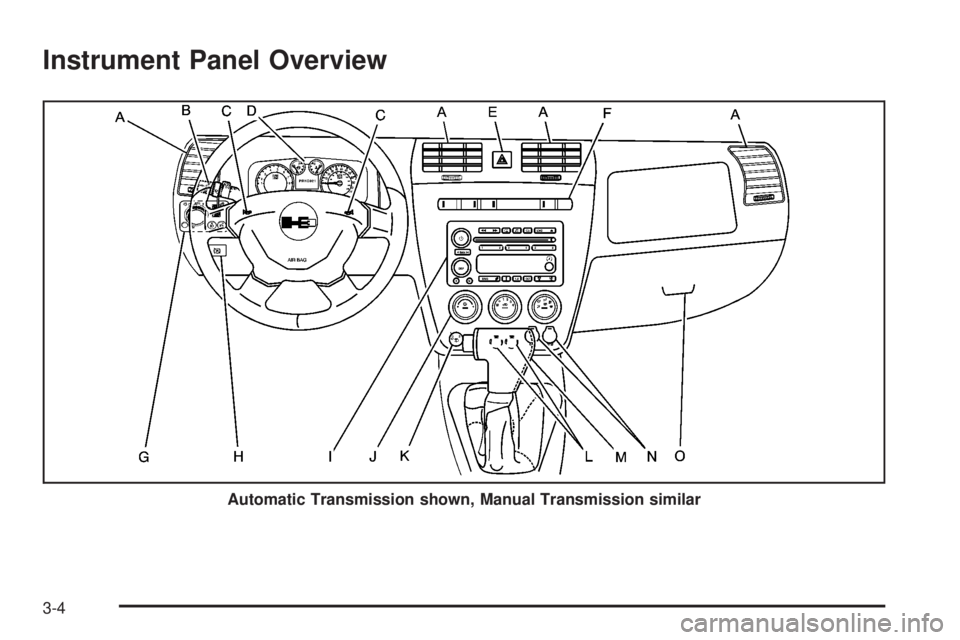
Instrument Panel Overview
Automatic Transmission shown, Manual Transmission similar
3-4
Page 139 of 416
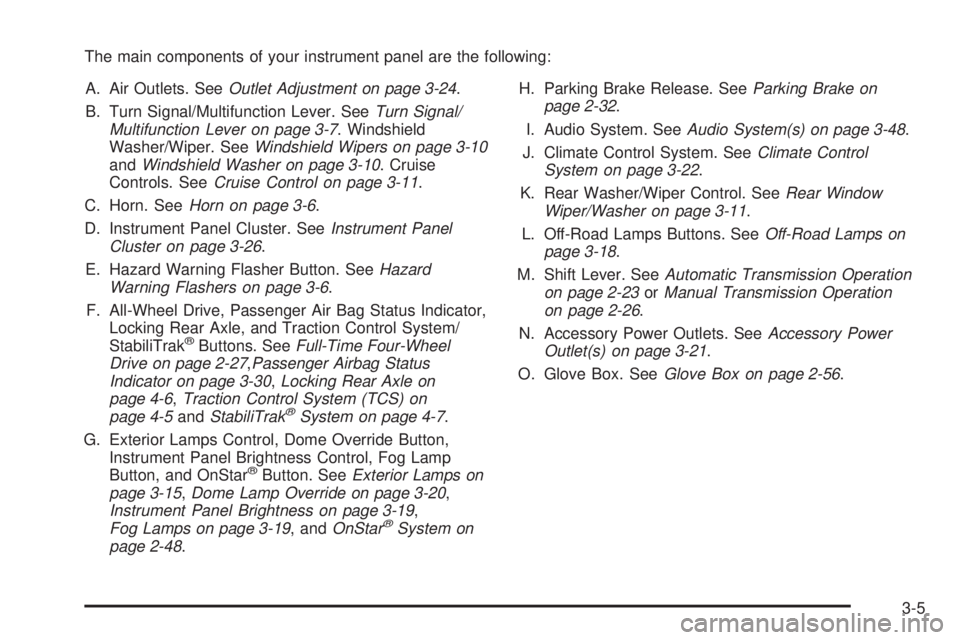
The main components of your instrument panel are the following:
A. Air Outlets. SeeOutlet Adjustment on page 3-24.
B. Turn Signal/Multifunction Lever. SeeTurn Signal/
Multifunction Lever on page 3-7. Windshield
Washer/Wiper. SeeWindshield Wipers on page 3-10
andWindshield Washer on page 3-10. Cruise
Controls. SeeCruise Control on page 3-11.
C. Horn. SeeHorn on page 3-6.
D. Instrument Panel Cluster. SeeInstrument Panel
Cluster on page 3-26.
E. Hazard Warning Flasher Button. SeeHazard
Warning Flashers on page 3-6.
F. All-Wheel Drive, Passenger Air Bag Status Indicator,
Locking Rear Axle, and Traction Control System/
StabiliTrak
®Buttons. SeeFull-Time Four-Wheel
Drive on page 2-27,Passenger Airbag Status
Indicator on page 3-30,Locking Rear Axle on
page 4-6,Traction Control System (TCS) on
page 4-5andStabiliTrak
®System on page 4-7.
G. Exterior Lamps Control, Dome Override Button,
Instrument Panel Brightness Control, Fog Lamp
Button, and OnStar
®Button. SeeExterior Lamps on
page 3-15,Dome Lamp Override on page 3-20,
Instrument Panel Brightness on page 3-19,
Fog Lamps on page 3-19, andOnStar
®System on
page 2-48.H. Parking Brake Release. SeeParking Brake on
page 2-32.
I. Audio System. SeeAudio System(s) on page 3-48.
J. Climate Control System. SeeClimate Control
System on page 3-22.
K. Rear Washer/Wiper Control. SeeRear Window
Wiper/Washer on page 3-11.
L. Off-Road Lamps Buttons. SeeOff-Road Lamps on
page 3-18.
M. Shift Lever. SeeAutomatic Transmission Operation
on page 2-23orManual Transmission Operation
on page 2-26.
N. Accessory Power Outlets. SeeAccessory Power
Outlet(s) on page 3-21.
O. Glove Box. SeeGlove Box on page 2-56.
3-5
Page 140 of 416
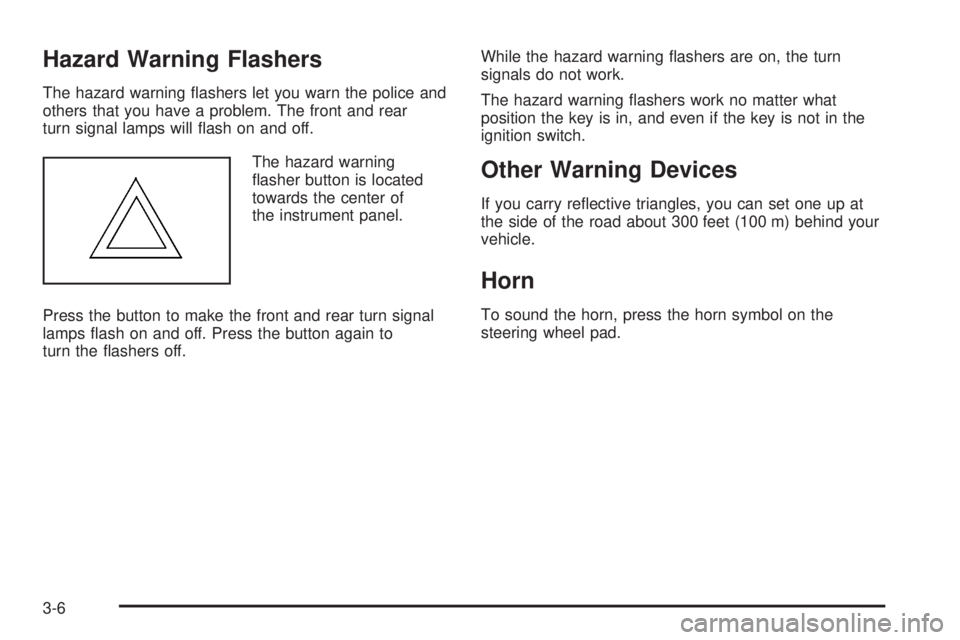
Hazard Warning Flashers
The hazard warning �ashers let you warn the police and
others that you have a problem. The front and rear
turn signal lamps will �ash on and off.
The hazard warning
�asher button is located
towards the center of
the instrument panel.
Press the button to make the front and rear turn signal
lamps �ash on and off. Press the button again to
turn the �ashers off.While the hazard warning �ashers are on, the turn
signals do not work.
The hazard warning �ashers work no matter what
position the key is in, and even if the key is not in the
ignition switch.
Other Warning Devices
If you carry re�ective triangles, you can set one up at
the side of the road about 300 feet (100 m) behind your
vehicle.
Horn
To sound the horn, press the horn symbol on the
steering wheel pad.
3-6